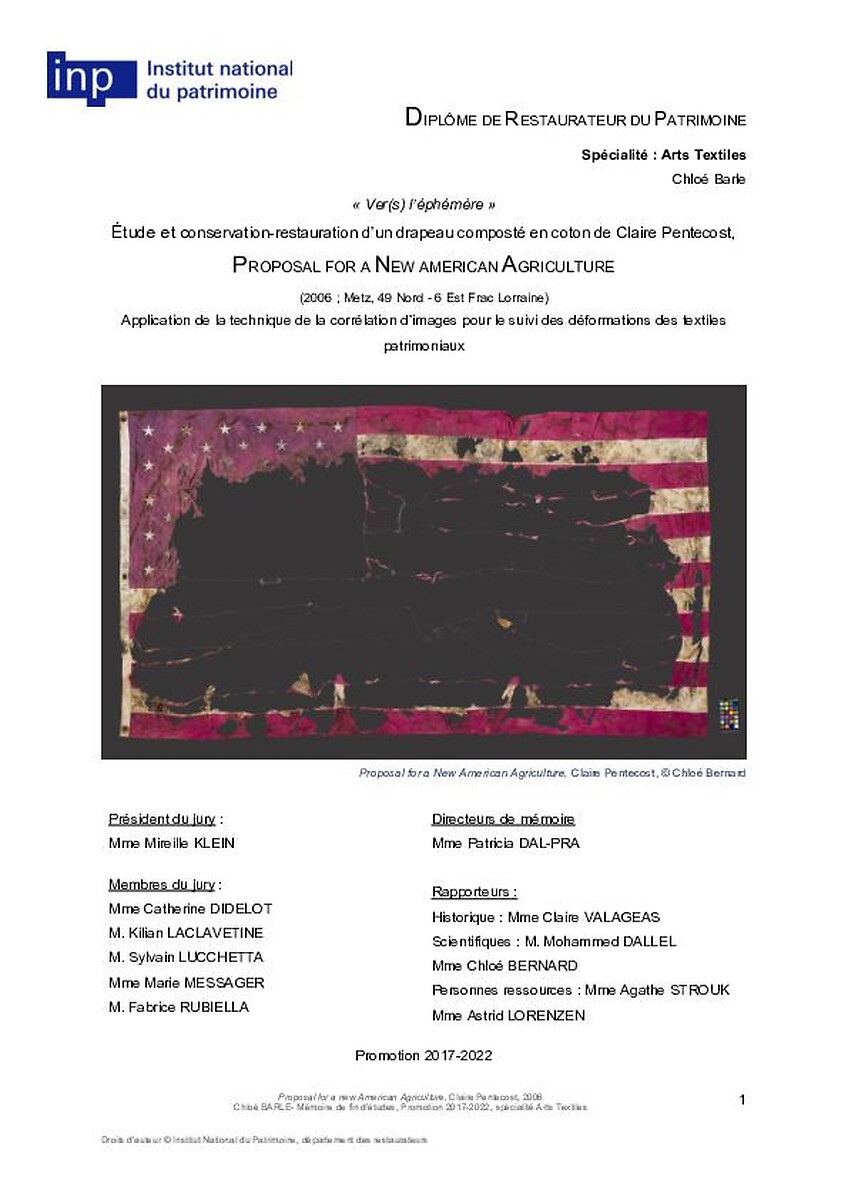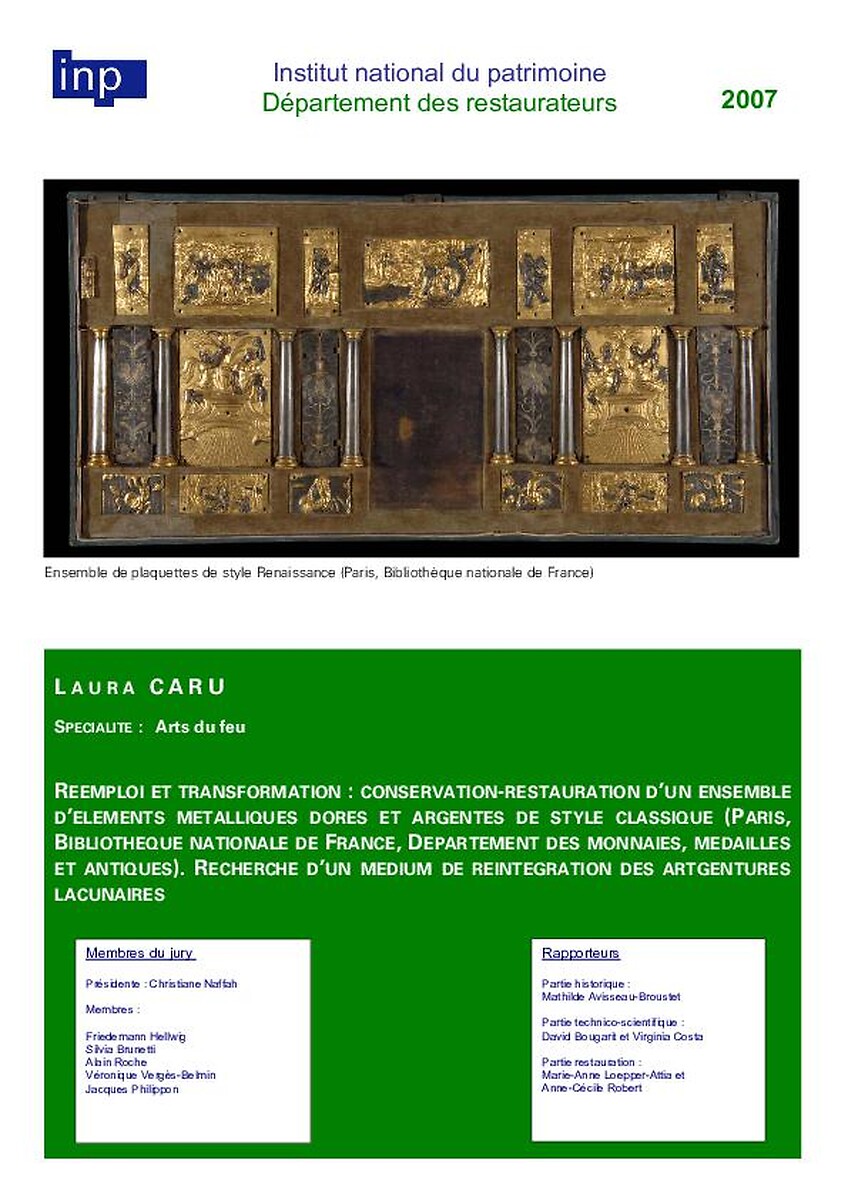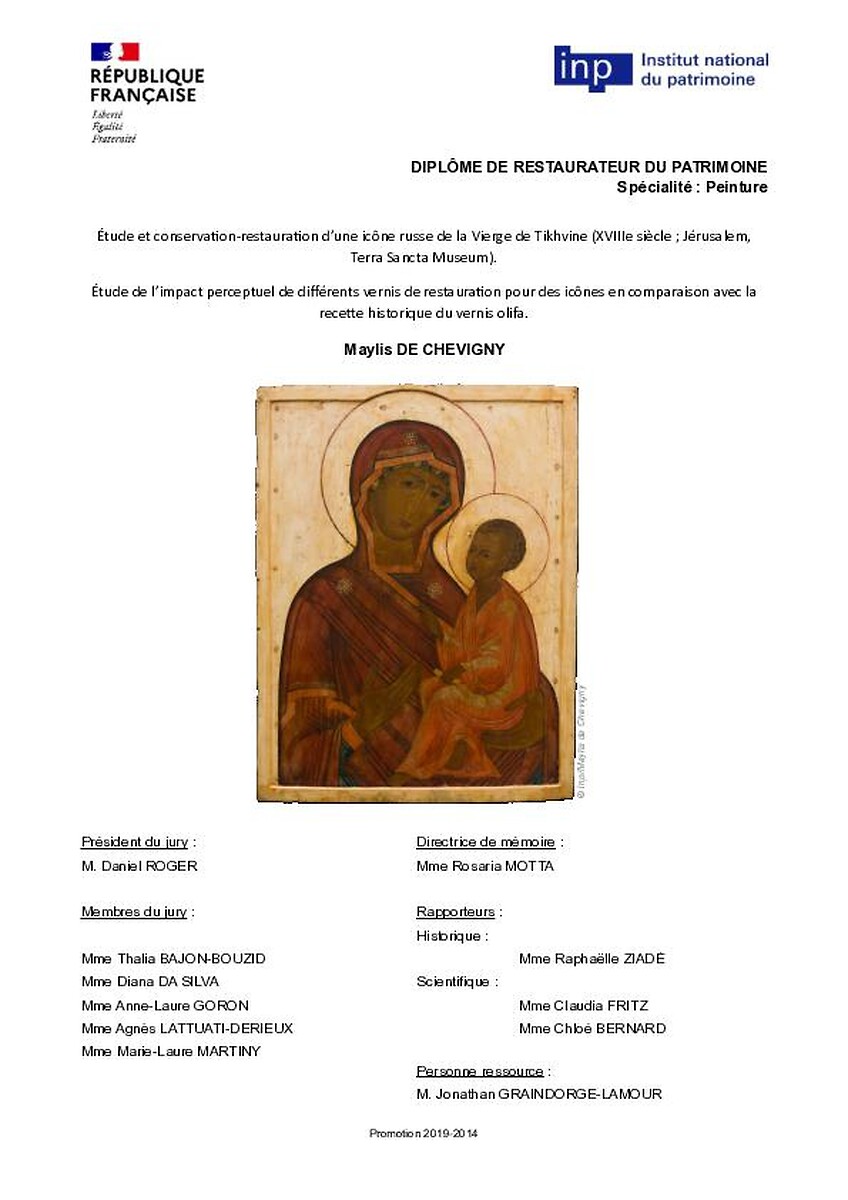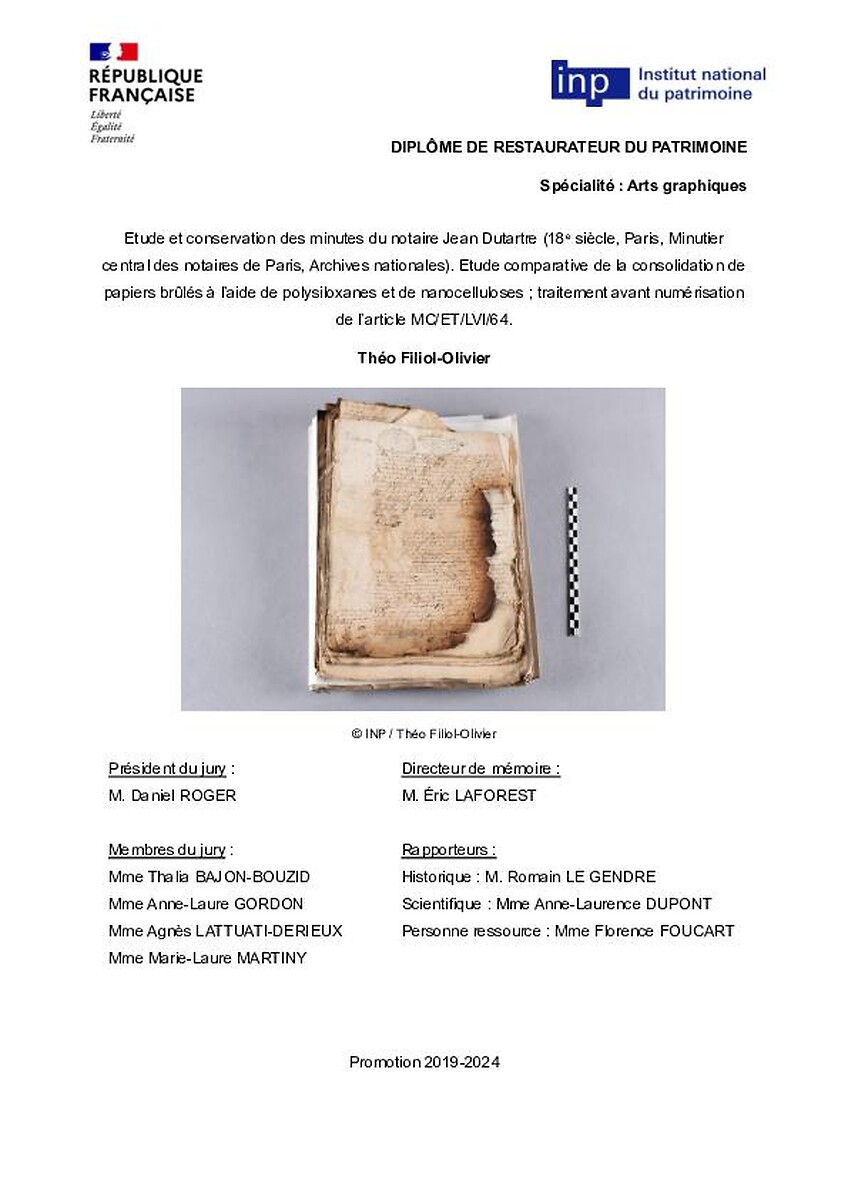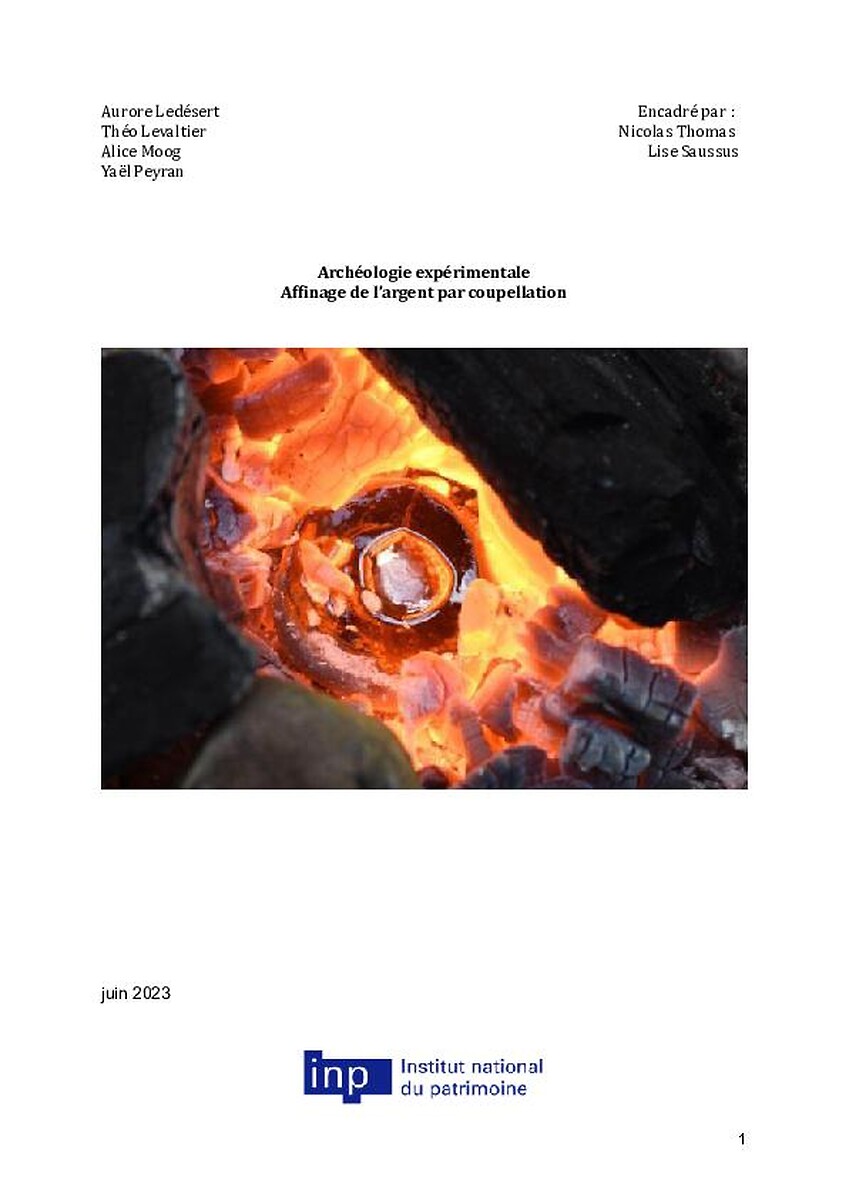« D'or, d'argent et de pte noire : incrustations révélées. » Etude et conservation-restauration de cinq objets islamiques en alliage cuivreux incrustés, issus de la collection Piet-Lataudrie (période médiévale et XIXe siècle ; Niort, musée Bernard d'Ages…
N° : 3001
application/pdf
- 28,7 Mo
- 403 page(s)
Description / Résumé
Ce Mémoire porte sur l’étude et la conservation-restauration d’un lot de cinq objets en alliage cuivreux incrustés de la collection islamique Piet-Lataudrie du musée Bernard d’Agesci de Niort.
Les métaux incrustés islamiques sont des objets historiquement convoités, mais pas toujours bien étudiés ce qui pose problème pour leur compréhension et leur conservation-restauration. L’étude inédite de la coupe, la boîte, son couvercle, le brûle-parfum et le pichet propose une traversée de l’art de l’incrustation islamique, du XIIe au XVIe siècle au Proche Orient et dans le monde iranien jusqu’en France en passant par le milieu des grands collectionneurs parisiens.
Ces informations n’étaient plus lisibles sur les œuvres, modifiées par différents produits d’altération menaçant leur conservation. Le caractère composite des objets (alliages cuivreux, argent, or, pâte noire, incrustations colorées, alliage de plomb) et leur morphologie rendait leur nettoyage particulièrement complexe à appréhender et propice à une étude technico-scientifique. Nous avons exploré une piste prometteuse : le nettoyage chimique à l’aide de couples de complexant et d’inhibiteur de corrosion en gel rigide, ayant pu être en partie appliqué lors des interventions de conservation-restauration des œuvres. Les interventions ont essentiellement porté sur le nettoyage des objets, leur consolidation et leur protection, leur restituant identité et lisibilité.
Les métaux incrustés islamiques sont des objets historiquement convoités, mais pas toujours bien étudiés ce qui pose problème pour leur compréhension et leur conservation-restauration. L’étude inédite de la coupe, la boîte, son couvercle, le brûle-parfum et le pichet propose une traversée de l’art de l’incrustation islamique, du XIIe au XVIe siècle au Proche Orient et dans le monde iranien jusqu’en France en passant par le milieu des grands collectionneurs parisiens.
Ces informations n’étaient plus lisibles sur les œuvres, modifiées par différents produits d’altération menaçant leur conservation. Le caractère composite des objets (alliages cuivreux, argent, or, pâte noire, incrustations colorées, alliage de plomb) et leur morphologie rendait leur nettoyage particulièrement complexe à appréhender et propice à une étude technico-scientifique. Nous avons exploré une piste prometteuse : le nettoyage chimique à l’aide de couples de complexant et d’inhibiteur de corrosion en gel rigide, ayant pu être en partie appliqué lors des interventions de conservation-restauration des œuvres. Les interventions ont essentiellement porté sur le nettoyage des objets, leur consolidation et leur protection, leur restituant identité et lisibilité.
Résumé en langue(s) étrangère(s)
Abstract : Five inlaid copper metalwork objects from the Piet-Lataudrie islamic collection belonging to the Bernard d’Agesci museum in Niort were studied for this master’s thesis research.
Islamic inlaid metalworks were sought-after, but not so much studied. This lack of knowledge can sometimes be an obstacle to their understanding and conservation. The previously unseen study of the cup, the box and its lid, the incense burner and the jug comes back to the inlaid working technique from the 12th to the 16th century ending in France passing through Parisian collections nets.
This information lost its legibility due to several degradations, which threaten the pieces’ conservation. Their composite materials (such as copper alloys, silver, gold, black material, coloured inlays and lead alloy) as well as their morphology made their cleaning difficult. This specific conservation process was studied through a scientific research. We studied the encouraging possibility of cleaning with stripping reagents combined with corrosion inhibitor in a rigid gel medium. It was partially applied for the objects cleaning, which was followed by consolidating and coating, making them identifiable and legible again.
Islamic inlaid metalworks were sought-after, but not so much studied. This lack of knowledge can sometimes be an obstacle to their understanding and conservation. The previously unseen study of the cup, the box and its lid, the incense burner and the jug comes back to the inlaid working technique from the 12th to the 16th century ending in France passing through Parisian collections nets.
This information lost its legibility due to several degradations, which threaten the pieces’ conservation. Their composite materials (such as copper alloys, silver, gold, black material, coloured inlays and lead alloy) as well as their morphology made their cleaning difficult. This specific conservation process was studied through a scientific research. We studied the encouraging possibility of cleaning with stripping reagents combined with corrosion inhibitor in a rigid gel medium. It was partially applied for the objects cleaning, which was followed by consolidating and coating, making them identifiable and legible again.
Islamic inlaid metalworks were sought-after, but not so much studied. This lack of knowledge can sometimes be an obstacle to their understanding and conservation. The previously unseen study of the cup, the box and its lid, the incense burner and the jug comes back to the inlaid working technique from the 12th to the 16th century ending in France passing through Parisian collections nets.
This information lost its legibility due to several degradations, which threaten the pieces’ conservation. Their composite materials (such as copper alloys, silver, gold, black material, coloured inlays and lead alloy) as well as their morphology made their cleaning difficult. This specific conservation process was studied through a scientific research. We studied the encouraging possibility of cleaning with stripping reagents combined with corrosion inhibitor in a rigid gel medium. It was partially applied for the objects cleaning, which was followed by consolidating and coating, making them identifiable and legible again.
Islamic inlaid metalworks were sought-after, but not so much studied. This lack of knowledge can sometimes be an obstacle to their understanding and conservation. The previously unseen study of the cup, the box and its lid, the incense burner and the jug comes back to the inlaid working technique from the 12th to the 16th century ending in France passing through Parisian collections nets.
This information lost its legibility due to several degradations, which threaten the pieces’ conservation. Their composite materials (such as copper alloys, silver, gold, black material, coloured inlays and lead alloy) as well as their morphology made their cleaning difficult. This specific conservation process was studied through a scientific research. We studied the encouraging possibility of cleaning with stripping reagents combined with corrosion inhibitor in a rigid gel medium. It was partially applied for the objects cleaning, which was followed by consolidating and coating, making them identifiable and legible again.
Auteur/artistes/intervenants
Direction scientifique ou pédagogique
Type de document
Institution(s) prêteuse(s) / Institution(s) partenaire(s)
Service producteur INP
Date de publication
Mots-clés
Localisation
Numéro de gestion de l'œuvre INP
Citer la ressource
Fays, Marie, "« D'or, d'argent et de pte noire : incrustations révélées. » Etude et conservation-restauration de cinq objets islamiques en alliage cuivreux incrustés, issus de la collection Piet-Lataudrie (période médiévale et XIXe siècle ; Niort, musée Bernard d'Ages…", Médiathèque numérique de l'Inp, 15 octobre 2018 (consulté le 19 décembre 2025), https://mediatheque-numerique.inp.fr/documentation-oeuvres/memoires-diplome-restaurateurs-patrimoine/dor-dargent-pte-noire-incrustations-revelees-etude-conservation-restauration-cinq-objets-islamiques-en-alliage-cuivreux-incrustes-issus
Type de licence
Tous droits réservés
Conditions d'utilisation
Cette ressource constitue une œuvre protégée par les lois en vigueur sur la propriété intellectuelle, dont les producteurs sont titulaires. Aucune exploitation commerciale, reproduction, représentation, utilisation, adaptation, modification, incorporation, traduction, commercialisation, partielle ou intégrale des éléments de cette ressource ne pourra en être faite sans l’accord préalable et écrit des ayants droit, à l’exception de l’utilisation pour un usage privé sous réserve des dispositions différentes voire plus restrictives du Code de la propriété intellectuelle.



